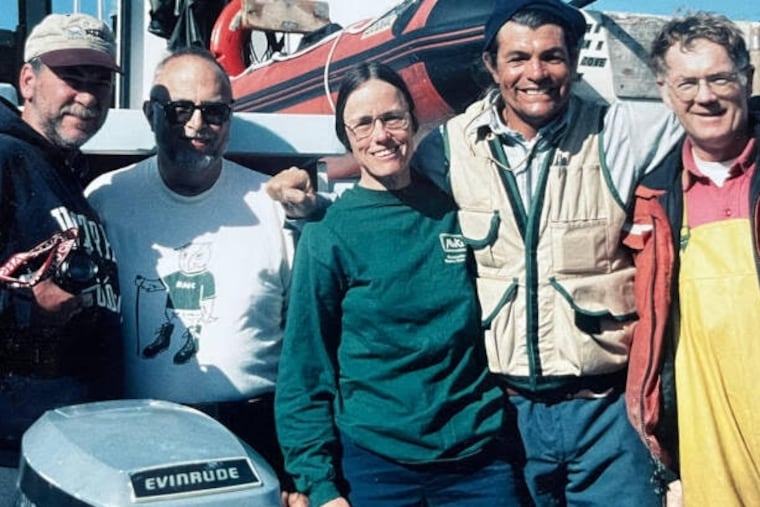Maria Luisa Crawford, celebrated geologist and professor emerita at Bryn Mawr College, has died at 84
She studied rocks she uncovered in Alaska, Canada, and Eastern Pennsylvania, and was heartened by the “greater collaboration among geoscientists” she helped create.

María Luisa Crawford, 84, of Haverford, celebrated geologist, professor emerita of geology at Bryn Mawr College, author, mentor, and adventurer, died Saturday, Nov. 4, at her home. The cause has not been announced. She had been living with age-associated decline.
Inspired by the volcanoes she saw in Guatemala as a child and an eye-opening class she attended in college, Dr. Crawford earned a degree in geology at Bryn Mawr College, traveled the globe for decades, and became a world-renowned expert on metamorphic rocks and the electron beam microanalysis she used to examine them.
She and her students and mostly-male colleagues studied metamorphic petrology: how, why, and when some rocks transform from one type into another over time. They climbed mountains in Alaska, Canada, Eastern Pennsylvania, and elsewhere to gather samples and map the folds of the formations.
She also did field work in Norway, looked into moon rocks for a time, and helped create an international geoinformation system to share new data.
She wrote dozens of scholarly papers and articles about plate tectonics, continental collisions, and related topics. She lectured to the Philadelphia Geological Society and other organizations, and was awarded a $320,000 MacArthur Foundation Fellowship to continue her work in 1993.
The Inquirer said in a 1993 article that she was “fluent in rock” and could “look at a rock, see how it’s shaped, study the contents and determine how old it is, how hot it was and how deeply it had been buried in the earth.”
She inspired students and colleagues at Bryn Mawr for 41 years, 27 as a professor, and as the William R. Kenan Jr. Eminent Professor of Geology from 1985 to 1992. She served as department chair and curator of the mineral collection for years, and helped create the environmental studies program.
She won Bryn Mawr’s 2001 McPherson Award for faculty excellence, retired in 2006, and was named a Top Lifetime Educator by the International Association of Top Professionals in 2018. She became a fellow at the Woodrow Wilson National Fellowship Foundation in 1960, and the Association for Women Geoscientists gave her an Outstanding Educator Award and administers the Crawford Field Camp Scholarship Fund for female geoscientists.
“I continue trying to convey to all I meet how wonderful and complex earth is and the many ways it influences our lives and how we influence it,” Dr. Crawford said in an online interview with the Woodrow Wilson Foundation. “This should be a part of everyone’s understanding.”
She also served on editorial boards for publications, advisory boards for universities, and committees for the National Science Foundation, Geological Society of America, and other groups.
Artist Henry Richardson was so inspired as a student by Dr. Crawford’s energy and critical thinking that he designed a spiral, 8-foot tall, 800-pound glass sculpture in 2021 in her honor. In a video about the sculpture’s creation, he called her “a brilliant scientist” and “true pioneer as a woman.”
María Luisa Busé was born July 18, 1939, in Beverly, Mass. She had family in Guatemala and traveled often between there and the United States as a child. They nicknamed her Weecha, and she was so brilliant that she mastered half-a-dozen languages by the time she graduated from Concord Academy in Massachusetts at 15.
She expected to major in languages at Bryn Mawr, but a chance geology class rekindled her longtime interest in the earth, and she graduated with a bachelor’s degree in 1960. She earned a Fulbright Fellowship and spent 1960 and 1961 at the University of Oslo in Norway, and then earned a master’s degree and doctorate in geology at the University of California, Berkeley, in 1965.
She met fellow geologist Bill Crawford in California, and they married in 1963, and lived in Bryn Mawr for 50 years. They both taught at the college and moved to Haverford about 20 years ago. He died in 2020. “We were equals all along the way,” she told the Wilson Foundation.
Dr. Crawford was an avid birder and photographer, gardener, and accomplished cook. She walked from home to the college on most work days and described herself recently on LinkedIn as “retired but researching.”
She mentored many students and invited them often to her annual Thanksgiving dinners. She was, said her nephew David Busé, “upbeat, curious, generous, positive, and overwhelmingly kind.”
In addition to her nephew, Dr. Crawford is survived by other relatives. Her brother, Rudy Busé, died earlier.
Services are to be at 11 a.m. Sunday, May 18, 2024, at St. Mary’s Episcopal Church, 36 Ardmore Ave., Ardmore, Pa. 19003.
Donations in her name may be made to the Maria Crawford Field Camp Scholarship Fund, Association for Women Geoscientists, 1333 West 120th Ave., Suite 211, Westminster, Colo. 80234.